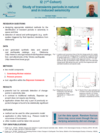PhD-Project I2 by Bernhard Fiedler (UP): Study of transient periods in natural and in induced seismicity
Timescale: Oct. 2015 – July 2019
Supervisors:
Dr. Sebastian Hainzl, Helmholtz Centre Potsdam GFZ German Research Centre For Geosciences
Prof. Dr. Matthias Holschneider, University of Potsdam
Prof. Dr. Gert Zöller, University of Potsdam
Background
Natural seismicity is a non-stationary process with various kinds of transient behaviour on different spatio-temporal scales, e. g., aftershocks, foreshocks, swarm activity, and quiescence on time-scales from hours to decades. Man-made earthquakes induced, e. g., by fluid injection in geothermal areas or waste-water disposals, share similar statistical features, but on a smaller spatial scale with transient boundary conditions. The knowledge of the transition times and characteristics is in both cases of particular importance for the estimation of the current state of the seismic hazard. The project aimed at improved identification of these transients by developing new statistical methods based on Bayesian methods. This allows for a straightforward assessment of uncertainties, which is crucial in the light of the overall low number of data points in typical earthquake catalogues.
Objectives and Methods
The project aimed at designing appropriate statistical methods for the identification of transient periods in seismicity in space and time, which included natural and anthropogenic (e.g. earthquakes triggered by fluid intrusion) deviations from stationarity. Methods of statistical and physical modelling of seismicity have been used along with modern techniques of Bayesian inference, uncertainty assessment and model selection. We used stochastic point processes to model seismicity; the identification of transients including uncertainty assessment was carried out with Bayesian techniques including parameter estimation, model comparison, and selection as well as change-point studies. Information criteria and the Bayes factor have been used for model selection.
Main results
- Development of an innovative & flexible Bayesian method for the automatic detection of change-points in seismicity data
- Identification of spatiotemporal change-points according to an increasing seismic activity in Oklahoma (due to the connection with industrial projects, the study area is of great public interest)
- Possibility to detect statistically significant changes of the frequency-magnitude distribution, which is relevant for seismic hazard estimations (while former studies used a moving window approach, which always leads to smearing effects, our method gives a new opportunity for the efficient detection of these transients)
Publications within NatRiskChange
FIEDLER, B., Hainzl, S., Zöller, G., Holschneider, M. (2018). Detection of Gutenberg–Richter b-Value Changes in Earthquake Time Series. Bulletin of the Seismological Society of America: 108 (5A): 2778–2787. doi: https://doi.org/10.1785/0120180091
FIEDLER, B., Zöller, G., Holschneider, M., Hainzl, S. (2018). Multiple change-point detection in spatio-temporal seismicity data. Bulletin of the Seismological Society of America, 108 (3A): 1147-1159. doi: https://doi.org/10.1785/0120170236

